It’s no secret that Utah is home to some of the most gorgeous national parks in the country, as well as some of the most gorgeous sites that aren’t technically national parks, but are managed by the federal government (like Bears Ears National Monument). For avid hikers and backpackers, ranking the state’s best national parks can be a challenge, even among those who live in Utah. If you’re from out of state with only a few days to visit a park, it gets even harder.
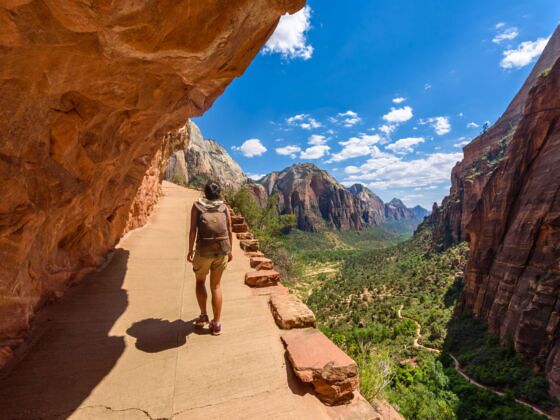
Bryce Canyon Vs. Zion National Parks: Which Park Is Right for You?
Fortunately, some parks are close to each other, like Arches National Park and Canyonlands National Park. In fact, they share the same gateway town of Moab. So if you’re deciding between those two parks, it’s easy to combine them in one trip.
But if you’re deciding to visit Zion or Bryce Canyon national parks, it gets a bit trickier — especially since both parks offer plenty to do to fill an entire long weekend. While they aren’t too far from one another, they’re too far apart to see both in a day, so you’ll need to pick one on shorter trips.
Here’s what to know to know about activities, hiking, weather, and more, to help you decide between visiting Zion and Bryce Canyon national parks.
Jump to:
- Environment and nature
- Seasonality and when to go
- Hiking and backpacking in Bryce Canyon vs. Zion
- Driving tours and accessible activities
- Other major things to do in each park
- Hotels in and around Bryce Canyon vs. Zion
- Frontcountry camping in each park
- Getting to each park
- Entry reservations at each park
- What kind of traveler will prefer each park?
Nature and environment
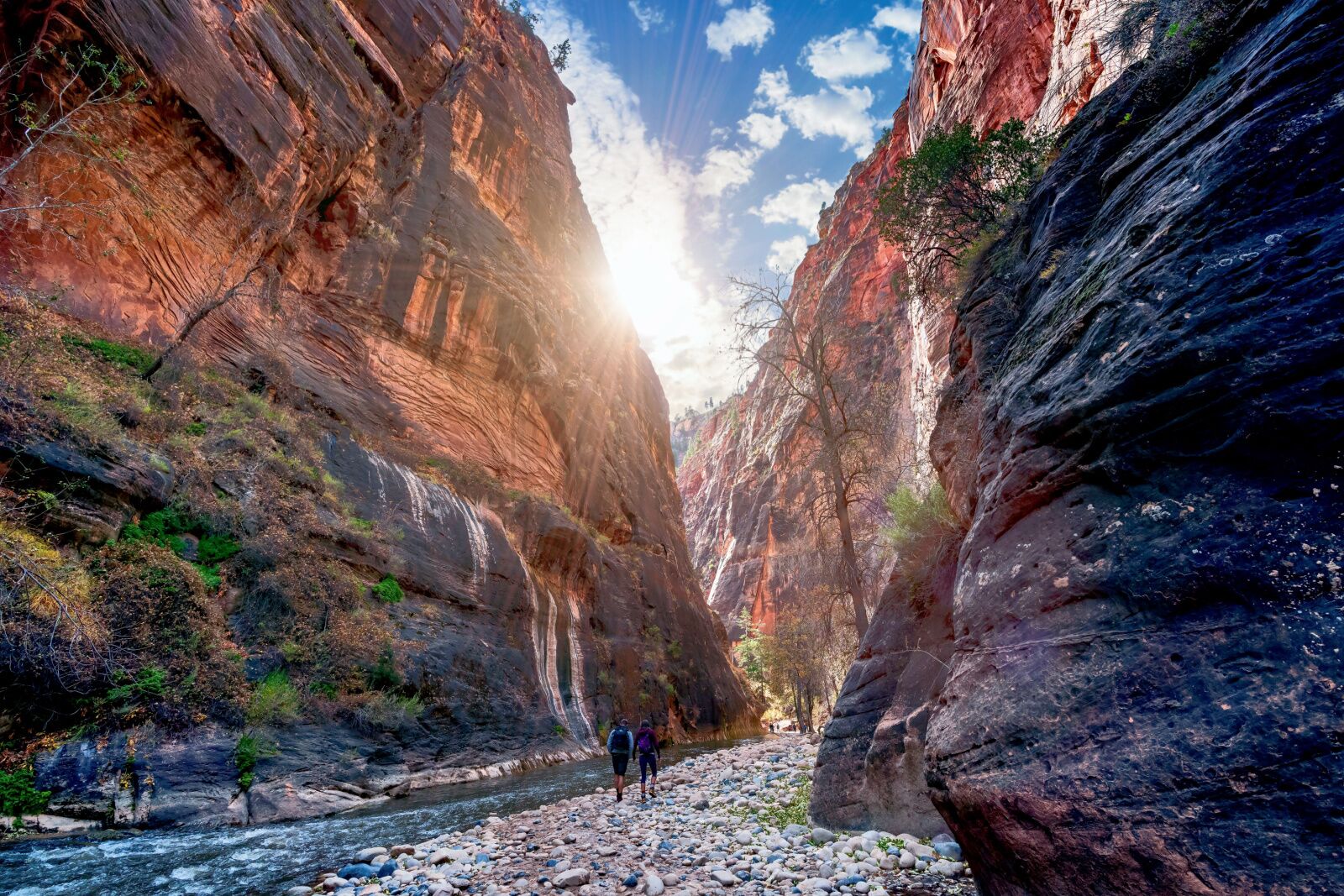
The Virgin River formed Zion’s famous canyon and created the steep walls of famous hikes like The Narrows. Photo: Sarah Quintans/Shutterstock
Zion and Bryce Canyon National Park are both in Utah, but the landscapes are quite different (at least in some areas of the park).
Zion’s main draw is gorgeous Zion Canyon, a red-rock chasm 15 miles long formed by eons of erosion by the Virgin River. In some places, the canyon’s walls are 3,000 feet high. Expect arid, dry conditions near the top with a mix of extreme heat and heavy snow, and more lush landscapes farther down closer to the river. In the transitions between climates, you’ll find gorgeous features like waterfalls and hanging gardens. Zion National Park’s main road (Zion Canyon Scenic Drive) is an out-and-back road that covers the first seven miles of the canyon.
Bryce Canyon is equally lovely, but with less abrupt and dramatic changes between elevations. But that’s not to say the landscape isn’t still dramatic. The park is famous for it’s hoodoos — spire-like rock formations sculpted by wind and frost. There are thousands of them in the “amphitheater,” the largest canyon in Bryce Canyon close to the Visitor Center. Bryce Canyon is generally cooler than Zion, as most of the park sits above 8,000 feet above sea level, and it has more forests than you’ll find around Zion.
Bryce Canyon’s entrance and roads are the top of the canyon, so it’s cooler and dryer. Zion’s Kolob Canyons area, in the northern part of the park (and not connected by roads to Zion Canyon), has weather more similar to Bryce Canyon.
Traveling to Zion or Bryce Canyon? Check out Matador’s Zion National Park lodging guides:
Seasonality and when to go

Bryce Canyon’s famous hoodoos covered in snow. Photo: ASGARALY LOULOUA/Shutterstock
When it comes to Zion versus Bryce Canyon, both have the same peak season: summer. That’s when weather is warmest (potentially too warm in Zion Canyon, where temperatures can regularly reach the high 80 degrees Fahrenheit range during the day), and kids are out of school, so family vacations are popular. Bryce Canyon is more pleasant in the summer as the temperatures get a bit cooler at night; July in Bryce has an average daytime temperature of 76 degrees and a nighttime low in the 40 degrees.
The temperature difference between the parks (a 15-degree or so difference at any given time) means Zion’s weather changes about a month ahead of Bryce Canyon. It’s still winter in Bryce Canyon in March, but it may be shorts-and-a-T-shirt hiking weather in Zion by then. Bryce Canyon also gets snow across the park, while Zion usually only gets snow on mountain peaks and around Kolob Canyon. So to avoid the crowds and still have good outdoor weather for hiking and other activities, visit Zion in March and April, or October and November; and visit Bryce Canyon in April and May, or September and early October.
In both parks, late July through early September is monsoon (heavy rain) season. Slot canyons and narrow canyons like the aptly named The Narrows in Zion can become deadly in a matter of minutes during heavy rain. If you’re planning on exploring canyons in either park, skip these months, or be ready to change your plans at the last minute based on weather.
Hiking and backpacking in Bryce Canyon vs. Zion
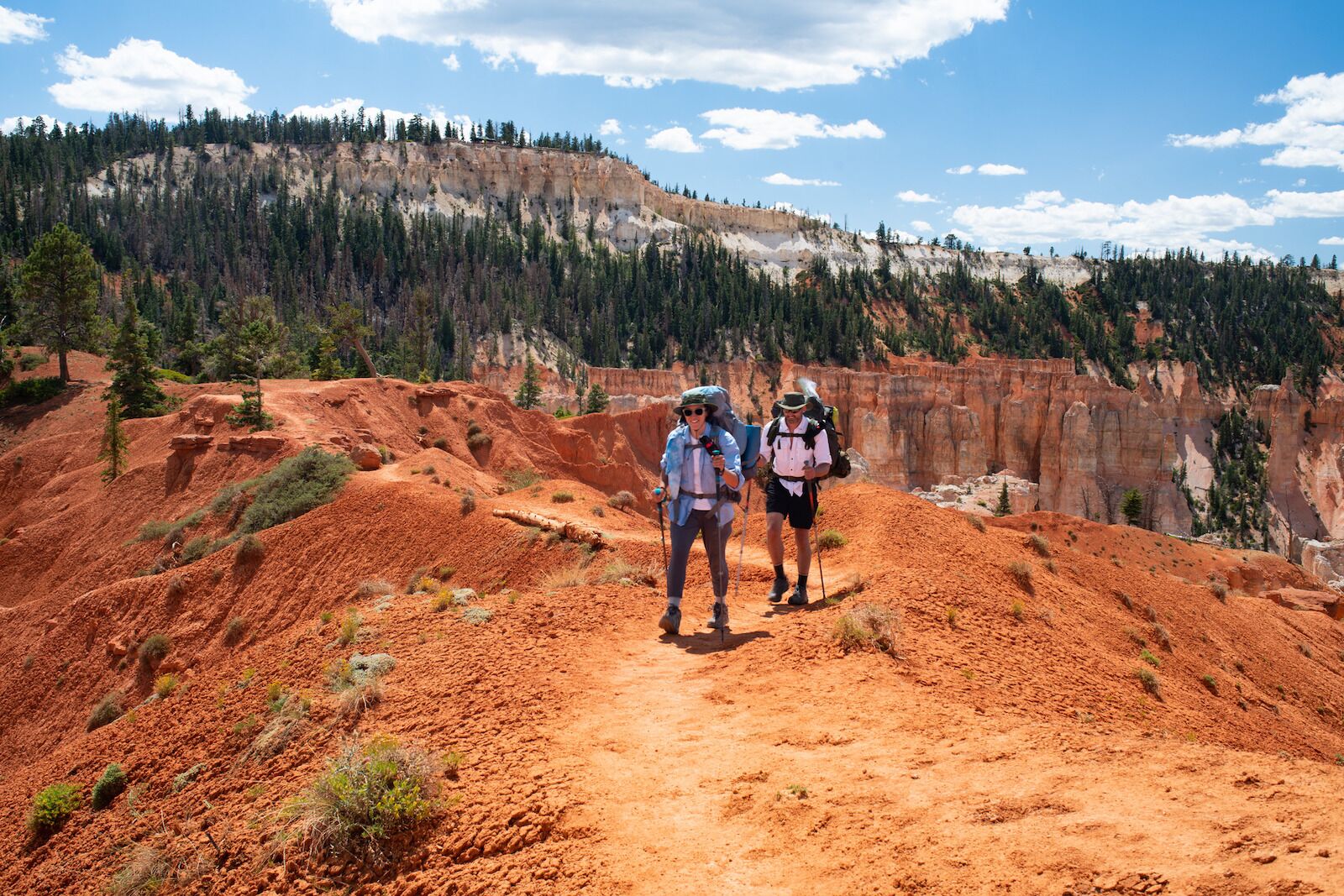
Backpackers in Bryce Canyon National Park, Utah. Photo: NPS/Peter Densmore/Public Domain
Both Zion and Bryce Canyon will keep hikers happy, but Zion has the edge for larger groups of hikers. That’s because Zion has more hiking trails, offering a wider range of challenge and variety. Zion is also home to some of the most famous hiking trails in the American West, like The Narrows through the Virgin River, and the famous Angels Landing. Zion’s lower elevation also gives it an edge when it comes to year-round hiking, as fewer trails will be covered in snow come December.
Zion’s most popular hiking trails are in Zion Canyon and start from one of nine different trailheads along Zion Canyon Scenic Road. Private vehicles are not allowed to drive on the road between March and November, so you’ll need to take the free shuttle from the Zion National Park Visitor Center to move between trailheads. You can also rent e-bikes from nearby stores, or run/walk the road, though it’s seven miles long. It takes about 45 minutes to get from the first stop (the Visitor Center) to the last stop (the Temple of Sinawava, starting point for The Narrows). Most trails start at the bottom and go up; Angels Landing gains 1,500 feet of elevation in 2.7 miles.
At Bryce Canyon, think of the trails as being opposite of those at Zion: you’ll start at the top and hike down. The park has fewer hikes, and most of them start in the amphitheater. The trails are a bit shorter than those at Zion and lead to viewpoints with excellent views of the hoodoos, meaning you don’t have to hike downhill if you’d rather not do much elevation gain. That’s in contrast to Zion, where you’ll have to hike up if you want views down into the canyon. However, Bryce does have some longer hikes, like the 8-mile Fairyland Loop, which loses (and gains) 1,900 feet of elevation.
Neither park is particularly known for backcountry hiking the way Yosemite or Grand Teton may be, but they both have a few options.
Bryce Canyon has two backcountry (overnight) hiking trails, and you’ll need to get a permit in advance online to hike them between March and November. From December 1 to February 28, permits are available on a walk-up basis from the Visitor Center. There’s a fixed number of passes available every day, so you should make your plans as far in advance as possible, but it’s not a cutthroat lottery system like you’d find at Glacier National Park. That said, summer weekends still fill up quickly. You can book your permits up to 90 days in advance on a rolling basis (so permits for July 1 become available on April 1). Review the backcountry hiking regulations at Bryce Canyon National Park in advance, especially the details about potable water and bear canisters.
There’s no backcountry hiking that stays in Zion Canyon, unless you count overnight trips that start from Chamberlain’s Ranch and end at the Temple of Sinewava (a 16-mile overnight hike). There are a few trails that start on Zion Canyon Scenic Drive, but most of the trails are in the park’s Kolob Canyon or Kolob Terrace areas. Only 50 percent of the backcountry permits are reservable online, and the other 50 percent are first-come, first-served one day ahead of time at the park’s visitor centers. Online permits for each month open on a specific date, so check the calendar in advance and have your account set up on Recreation.gov ahead of time.
Zion is more popular than Bryce Canyon, and backcountry permits usually get taken quickly.
Driving tours and accessible activities
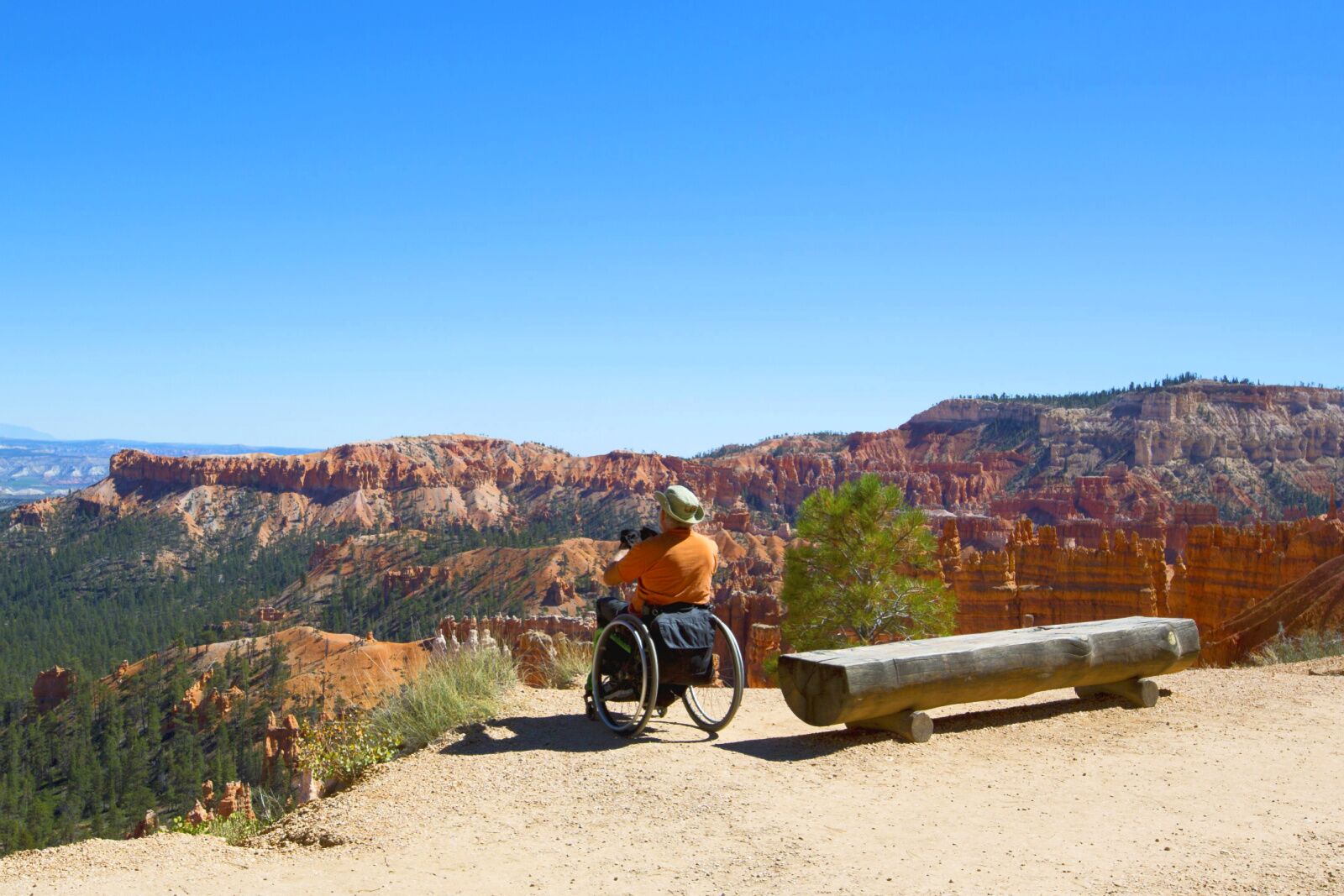
Most of the popular viewpoints around the Bryce Canyon Amphitheater are wheelchair-friendly. Photo: Leonard Zhukovsky/Shutterstock
Neither Bryce Canyon or Zion are particularly ideal for driving tours. Zion National Park’s main road is the 7-mile, out-and-back Zion Canyon Scenic Drive, so it’s not much of a tour. But the park bus system is free, so you certainly could just go for a ride out and back on the shuttle. It would be about a 90-minute roundtrip ride to the Temple of Sinewava and back. If you get a window seat, you’d at least be able to check out the dramatic rock formations along the canyon. You can also drive Zion-Mount Carmel Highway, a scenic, upper-elevation route outside the canyon with views from multiple overlooks, including Checkerboard Mesa and Canyon Overlook Trail.
If you visit in August, you can book an open-air tram ride along the scenic drive via the park’s Zion Lodge.
Bryce Canyon has one entrance and one road: the Southern Scenic Drive. It starts at the Visitor Center and takes about 40 minutes to reach the turn-around point. Most of the prettiest viewpoints in the park are along this road, so it’s a good way to see the park’s main attractions with minimal hiking. There’s a guided audio accompaniment for it available on the National Park Service app.
Bryce Canyon doesn’t ban personal vehicles like Zion does, but the parking lots can fill up early in the morning. So you may instead want to make use of the free Bryce Canyon National Park shuttle, which stops at multiple points along the road, as well as a few spots in the nearby town of Bryce Canyon City. It runs from April to mid-October.
Aside from the park shuttles, there are no driving tours in Bryce Canyon or Zion national parks. But all the visitors centers and museums in both Bryce Canyon and Zion are ADA-compliant. In Zion, the Pa’rus Trail is paved and a good option for visitors with limited mobility. In Bryce Canyon, there’s a very detailed guide to accessibility at each of the amphitheater’s most famous viewpoints, and a full park-wide accessibility guide is available at the Visitor Center. Both parks also have large-print guides and seasonal ranger programs that accommodate all guests.
Other major recreational draws
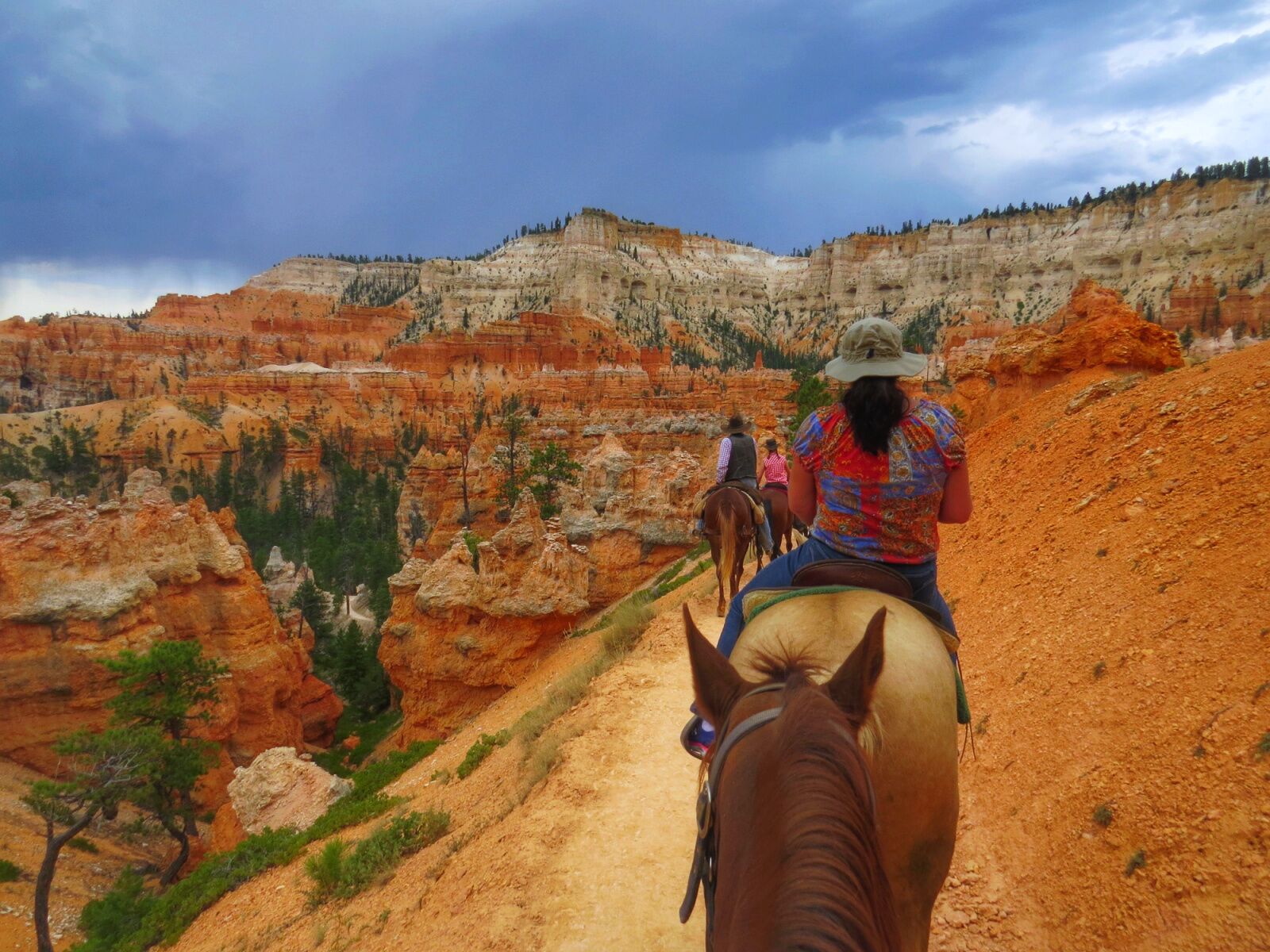
Visitors on a guided horseback ride through Bryce Canyon National Park. Photo: Brookie Cookie/Shutterstock
Love stargazing at national parks? Good news: you don’t need to choose between Bryce Canyon vs. Zion. Both are certified International Dark Sky Parks and have night sky programs throughout the year hosted by rangers. There are plenty of trails in Zion ideal for stargazing, and Bryce Canyon National Park hosts ranger-led full-moon hikes.
Both parks are also popular with people who want to explore trails on horseback. Bryce Canyon offers tours through the park from April to October, and Zion offers horseback riding from March to October. There’s one company that offers tours: Bryce-Zion Trail Rides, and it’s the only trail riding outfitter authorized to operate within the two parks.
In terms of other activities, Zion is known as having a bit more variety. Canyoneering is very popular; experts can do it on their own, while beginners and novice visitors should use a licensed guide like Red Desert Adventures or East Zion Adventures. It’s also known for rock climbing, but the routes are generally pretty advanced. So if you’re a beginner, use a guiding company like Rock Odysseys or Zion Guru. There’s also the “Above Zion” via ferrata on the outskirts of the northern part of the park, which has some of the most stunning views in the Kolob Canyons area — but be cautious if you have a fear of heights.
Hotels and nearby towns
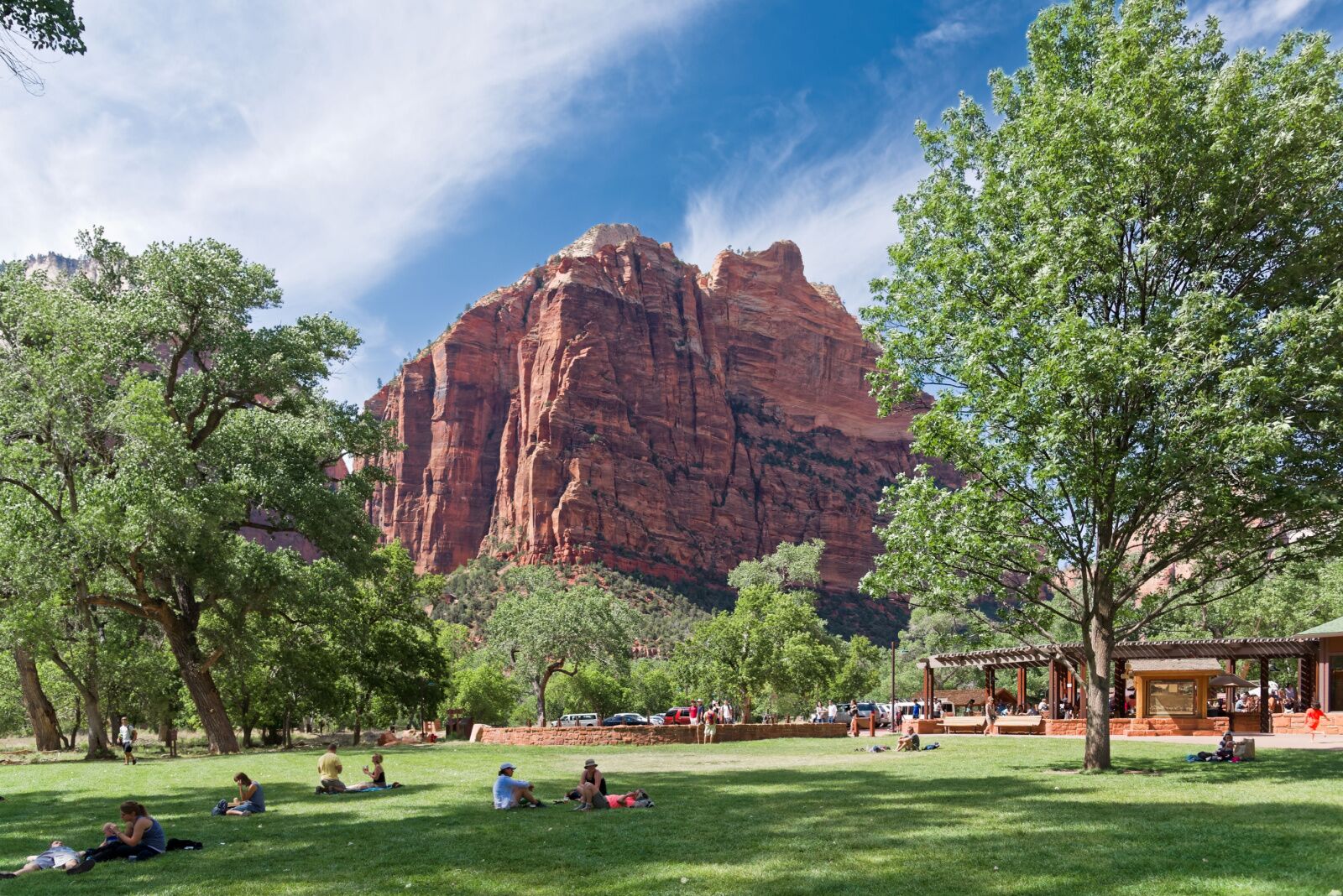
Zion Lodge is a historic national park hotel halfway down Zion Canyon Scenic Drive and the only hotel within the park boundaries. Photo: Patrizio Martorana/Shutterstock
Both Bryce Canyon and Zion national parks have an in-park hotel. Zion’s is the Zion Lodge, and Bryce Canyon’s is the Bryce Canyon Lodge. The Zion Lodge is open year-round, while Bryce Canyon’s hotel is only open from late March to early November.
If you can’t find a room in either park, it’s no big deal. The main entrance to Zion National Park is in the town of Springdale, and Bryce Canyon is in Bryce Canyon City. The latter is only about two miles from the entrance to Bryce Canyon National Park, and depending on where you stay in Springdale, you can walk to Zion.
If you stay in Springdale, consider booking a Zion National Park Airbnb or hotel within walking distance to one of the free Springdale shuttles. The town gets very crowded, and the parking lot at Zion National Park’s main visitor center can fill quickly, so it’s much easier to take the free town shuttle to the park entrance, rather than dealing with your own car. There are also lots of rental cabins near Zion.
Bryce Canyon City doesn’t get quite as busy, so it’s not as hectic and hotels can be a little cheaper. It also means there’s a little more space on the outskirts of town, and you’re more likely to find larger, more private Bryce Canyon Airbnb rentals fairly close to the park, whereas in Zion, rentals with more land will be farther out (and pricier).
Camping in Bryce Canyon vs. Zion

Watchman Campground in Zion National Park. Photo: Andriy Blokhin/Shutterstock
If camping is your game, you’ll want to reserve your campsites in advance on Recreation.gov. Zion has three campgrounds, but only one, Watchman Campground, is in Zion Canyon. It’s very close to the park entrance and is open year-round. All campsites are available for advanced booking, and reservations open on a rolling basis six months in advance. It fills up quickly, so try to book your Watchman Campground reservation as far in advance as possible. It’s not unusual for weekends in June and August to be full by March. You can walk to restaurants in Springdale, so it’s pretty easy camping.
Zion’s two other campgrounds are the South Campground (closed indefinitely for restoration) and Lava Point Campground on Kolob Terrace Road (about 90 mins from the Springdale entrance). Lava Point is open only from May to September as it gets much more snow, and campground reservations open two weeks ahead of time on a rolling basis. It’s far less popular, but only has six sites, so plan accordingly.
Campers at Bryce Canyon have two choices: the North Campground or Sunset Campground. The North Campground is by the Visitor Center while the Sunset Campground is about 1.5 miles south of it, but it’s only about a 10 minute walk between the two. Both are also on the park’s shuttle route.
The North Campground is open year-round and is first-come, first-served between early October and mid-May. During the summer, you’ll need to make a reservation for Bryce Canyon’s North Campground online on Recreation.gov. Sites fill up quickly and open on a six-month rolling basis — so if you want to camp on September 15, make your reservation on March 15.
The Sunset Campground is closed from late October to mid-April. You do need to make reservations for the Sunset Campground for stays between mid-May and mid-October. They’re available on Recreation.gov and open two weeks ahead of time on a rolling basis.
Since the campgrounds are close to each other, and Bryce Canyon isn’t that big, it doesn’t matter much which campground you choose. There’s even a little general store in the summer near the Sunset Campground (with hot coffee), so you don’t have to walk to the Visitor Center to buy things, or even do much camp cooking, if you don’t want to.
Getting to Bryce Canyon vs. Zion
On a map, it looks like Bryce Canyon and Zion aren’t too far from one another, but the distance can be deceiving. Bryce Canyon has only one entrance, and it’s on the opposite side of Zion, so it takes about 2.5 to 3 hours to drive between them. Google Maps will say it’s about two hours, but when you account for traffic and delays entering and exiting the parks, you’re looking at a bit more depending on timing.
The closest airport to Zion National Park is St. George Airport in Utah. It connects to Salt Lake City, Denver, Phoenix, and Dallas, so depending on where you live, you may be able to get there with just one stop. The St. George Airport is about 45 minutes from Springdale. The largest major airport to Zion National Park is Harry Reid International in Las Vegas. It’s about a three-hour drive from Las Vegas to Zion, and it’s one of the most beautiful road trips in that part of the country, with gorgeous places to stop along the way.
For Bryce Canyon, the airport in Cedar City, Utah, is the closest, at about 1.5 hours away. However, it connects only to Salt Lake City, which can be inconvenient. If that doesn’t work, you’ll need to use the same airports as Zion (St. George is about a three-hour drive) or you can use Page Municipal Airport in Arizona (also about three hours away), which connects to Phoenix and is also very close to Grand-Staircase Escalante National Monument.
Both parks have seasonal road closures in the high-elevation areas. In Bryce Canyon, roads closures can happen for snow or snow-clearing, so check the Bryce Canyon National Park road status website if you’re visiting between December and March. Zion is also subject to snow closures on some roads. Check the bottom of the Zion National Park seasonal status website, or follow @ZionNPS on X, which posts road closure updates. The roads around Kolob Canyons are especially prone to closures.
Park reservations and permits

Zion National Park, Utah. Photo: Galyna Andrushko/Shutterstock
Reservations at Bryce Canyon and Zion national parks are pretty straightforward: you do not need entry reservations at either park, unlike nearby Arches National Park or California’s Yosemite National Park. However, both parks do require permits for specialized activities like canyoneering or self-guided paddling trips.
However, there is one hike that requires a permit year-round: Angel’s Landing in Zion. Reservations open four times per year; permits for summer hiking dates open on April 1 on Recreation.gov. You can submit up to seven dates, ranked in priority order. There’s also a day-before online lottery — enter by 3 PM on Recreation.gov, and you’ll find out by 4 PM if you got a permit for the next day. You do not need a permit for the park’s other famous hike, The Narrows, though you can reserve rental waders and boots online.
What kind of person will like each park?
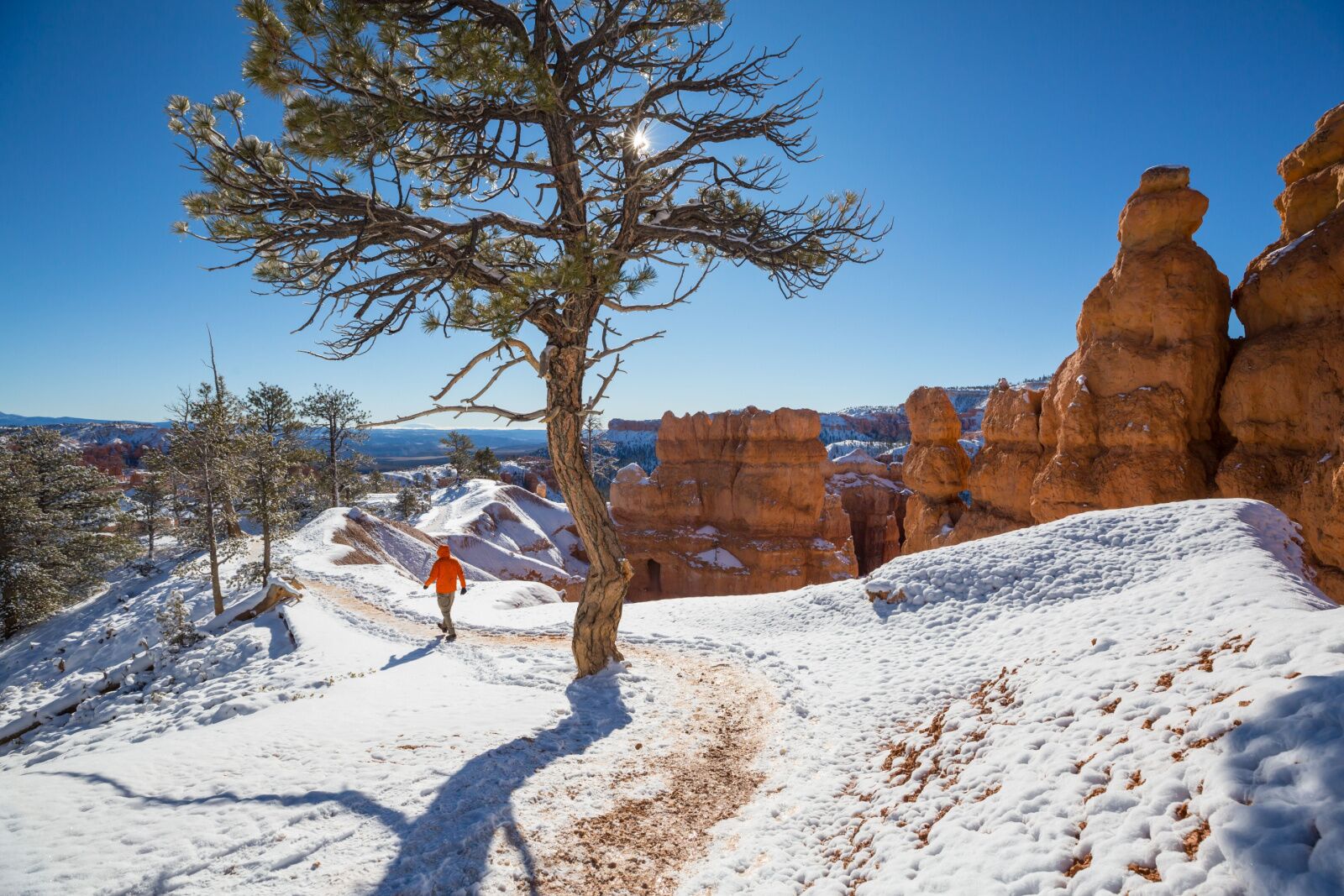
Bryce Canyon’s landscapes have snow in higher elevations through April. Photo: Galyna Andrushko/Shutterstock
Truthfully, most people who like being outdoors will like both parks. But visitors who are keen to see otherworldly landscapes might find themselves drawn more to Bryce Canyon National Park than Zion. Bryce Canyon’s famous hoodoos look like a half-fairytale, half-Martian movie set, especially around the crimson-colored amphitheater. When it comes to crowds at both, Bryce Canyon is certainly less crowded, especially on some of the longer hikes with steeper elevation gain. Zion generally attracts larger crowds, especially on trails like The Narrows and on easier hikes in Zion Canyon Scenic Drive. However, Zion’s region of Kolob Canyons does have fewer visitors.
If you’re after more outdoor activities other than hiking, especially more high-adrenaline activities like rock climbing or canyoneering, Zion may be a better pick. Since Zion is more popular, there are more activity operators and guided adventures in the area. Zion is also much larger and has more hiking trails with more variety, which may be more appealing to visitors looking to hike multiple days in a row, or with groups of split ability levels. Conversely, Bryce Canyon has more viewpoints and vistas for non-hikers, since the road is at the top of the canyon, not the bottom.
Weather-wise, if you’re visiting in winter and want peaceful landscapes, it’s hard to beat the views of Bryce Canyon’s snow-covered hoodoos. But if you’re sick of winter and want to get a jump on hiking season in February, Zion will be warmer and more pleasant. And campers afraid of getting too cold will also prefer Zion, since Bryce Canyon’s nighttime temperatures can get much lower those in Zion, even in the summer.